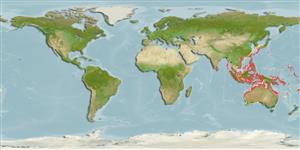>
Eupercaria/misc (Various families in series Eupercaria) >
Labridae (Wrasses)
Etymology: Labropsis: Greek, labrax, -akos = a fish, Dicentrarchus labrax + Greek,opsis = appearance (Ref. 45335).
Environment: milieu / climate zone / depth range / distribution range
Ecologie
marien rifbewoner; diepte 5 - 30 m (Ref. 2137), usually 5 - 20 m (Ref. 27115). Tropical; 24°C - 27°C (Ref. 27115)
Indo-West Pacific: Western Australia (Scott Reef) to Papua New Guinea; north to Japan.
Grootte / Gewicht / Leeftijd
Maturity: Lm ? range ? - ? cm
Max length : 11.7 cm SL mannelijk / geslacht onbekend; (Ref. 2137)
Dorsale stekels (totaal) : 9; Dorsale zachte stralen (totaal) : 11; Anale stekels: 3; Anale zachte stralen: 10; Wervels: 25. Body of male orangish in life; large females similar in body color with males except for the absence of the large orange area beneath and around the pectoral fin base and the black spot on the dorsal fin. Inconspicuous stripes on head of females; juveniles and small females with 3 broad black stripes on head and body, separated by narrow pale blue stripes. Posterior caudal peduncle and fin principally dark brown or black. Juveniles nearly identical to juveniles of Diproctacanthus but have a longer dorsal fin (Ref. 48636).
Occurs solitary or in small groups (Ref. 90102) in rich coral reefs in clear coastal to outer reef habitats. Adults feed on coral polyps but may also clean (Ref. 48636). Minimum depth range from Ref. 27115.
Levenscyclus en paargedrag
Maturities | Voortplanting | Spawnings | Egg(s) | Fecundities | Larven
Oviparous, distinct pairing during breeding (Ref. 205).
Randall, J.E., 1981. Revision of the labrid fish genus Labropsis with description of five new species. Micronesica 17(1-2):125-155. (Ref. 2137)
Status op de Rode Lijst van het IUCN (Ref. 130435)
Gevaar voor de mens
Harmless
Gebruik door de mens
Visserij: commercieel; Aquarium: Commercieel
Tools
Speciale rapporten
Download XML
Internetbronnen
Estimates based on models
Preferred temperature (Ref.
123201): 22.9 - 28.9, mean 27.8 °C (based on 532 cells).
Fylogenetische diversiteitsindex (Ref.
82804): PD
50 = 0.5156 [Uniqueness, from 0.5 = low to 2.0 = high].
Bayesian length-weight: a=0.00955 (0.00456 - 0.02002), b=3.06 (2.89 - 3.23), in cm total length, based on LWR estimates for this (Sub)family-body shape (Ref.
93245).
Trofisch niveau (Ref.
69278): 3.3 ±0.61 se; based on food items.
Weerstandsvermogen (Ref.
120179): Hoog, minimale populatieverdubbelingstijd minder dan 15 maanden (Preliminary K or Fecundity.).
Fishing Vulnerability (Ref.
59153): Low vulnerability (10 of 100).
Nutrients (Ref.
124155): Calcium = 113 [66, 199] mg/100g; Iron = 0.808 [0.465, 1.516] mg/100g; Protein = 18.3 [15.4, 20.5] %; Omega3 = 0.164 [0.101, 0.267] g/100g; Selenium = 21.9 [12.5, 40.5] μg/100g; VitaminA = 172 [52, 652] μg/100g; Zinc = 2.03 [1.37, 3.26] mg/100g (wet weight);
